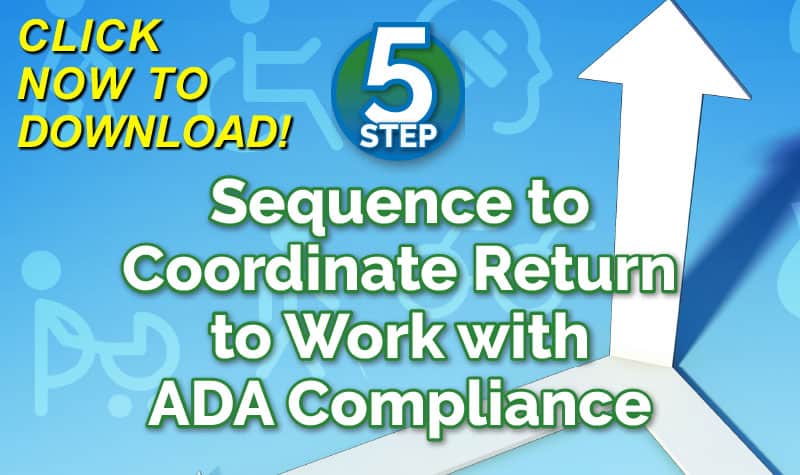Think workers comp is hard to manage? Try FMLA, state and other leaves of absence, then add in the workers compensation issues and you may have a nightmare.
Click Link to Access Free PDF Download
“5-Step Sequence to Coordinate Return-to-Work with ADA Compliance”
These overlapping and ever-changing leave laws are so complicated many employers either grant too much leave in fear of being out of compliance, or refuse leave that legitimately should be granted, exposing the employer to risk of lawsuits.
How employers (and/or their TPAs) manage FMLA can have a big impact on costs, productivity, employee morale and, perhaps most important, reduce the risk of legal action for claims of noncompliance. Quite simply, it pays to devote the resources to make sure it is done right.
To give you an idea of how complicated managing these leaves can be, consider this hypothetical scenario and how it should be correctly handled. While reading, keep in mind that, while this scenario looks overblown, in real life it actually can get much more complicated than this.
Pregnant Employee With Multiple Births
This scenario illustrates the interaction of FMLA and state leaves for an employee with a complicated pregnancy.
Judy in Massachusetts is employed by a company that is covered by both the FMLA and the Massachusetts Maternity Leave Act (MMLA). She becomes pregnant with multiple fetuses with a due date of October 15 and is put on bed rest by her OB effective April 15. On August 30 she delivers eight babies, all of which survive.
How much job-protected leave does Judy get, and under which statutes?
April 15 – July 8
1. The MMLA covers only the birth or adoption of a child or children, not pre-birth pregnancy-related disabilities. Therefore, the MMLA does not cover any of her pre-birth time off.
2. The FMLA does cover pregnancy-related disabilities, so this provides job protection for Judy for up to 12 weeks during her period of bed rest.
3. After 12 weeks, Judy exhausts her FMLA on July 8 (assuming she has not taken any other FMLA time in the prior 12 months).
July 9 – August 14
1. Judy is out of FMLA and the MMLA has not yet come into effect. She is likely still protected, however, under the Americans with Disabilities Act (as amended by the ADA Amendments Act effective January 2009) and under the Massachusetts equivalent nondiscrimination law.
2. Judy also may be protected by both federal and Massachusetts sex or pregnancy discrimination laws if her employer allows leaves of absence to employees for non-pregnancy-related temporary disabilities.
3. Her employer would be wise to provide an extended leave of absence due to her pregnancy and/or pregnancy disability to cover the period from FMLA exhaustion until the MMLA provides the employee with parental/bonding leave.
August 15 and onward
Once Judy has given birth, the MMLA allows eight weeks of job-protected leave per birth or adoption.So, for having eight babies, she is entitled to 64 weeks of leave, eight for each baby.
What Should You Be Doing to Better Manage Leaves?
The takeaway from this examples is that leave laws form a complex web that continually has to be untangled for each case. In addition, these laws are constantly being amended and updated as challenges are decided on in court.
Every employer should:
1. Make sure supervisors are aware that leave laws are complex and that they should not try to handle leave requests without help from their HR, benefits, or legal department.
2. Make sure supervisors are aware their attitude is important, and that if they respond negatively to requests for leave, it could be construed as FMLA interference and expose the employer to potential legal action.
3. Understand that employers do not have to grant every leave request just to avoid the risk of noncompliance. With proper understanding of leave laws, there are many ways that employers can reduce the burden of unnecessary leaves while still giving employees the leaves to which they are entitled.
Up-to-Date Leave Law Information is the Key.
No human being can be expected to hold this kind of complexity in his or her head, and researching leaves on various government databases is both time consuming and increases the risk of missing any important change or guidance on a gray area. Be sure you have the most current information on FMLA, state and other leave laws available in a format that is easy to search, complete and always up-to-date. If you encounter any “gray areas” in leave laws, be sure to seek expert advice to minimize the risk of legal challenges.
Martha J. Cardi is Chief Compliance Officer for Reed Group and Chief Editor of Reed Group’s Leave of Absence Advisor, a web-based resource for administering FMLA, state and other leave laws. More info at www.reedgroup.com. Contact at services@reedgroup.com.
Our WORKERS COMP BOOK: www.WCManual.com
WORK COMP CALCULATOR: www.LowerWC.com/calculator.php
MODIFIED DUTY CALCULATOR: www.LowerWC.com/transitional-duty-cost-calculator.php
SUBSCRIBE: Workers Comp Resource Center Newsletter
Do not use this information without independent verification. All state laws vary. You should consult with your insurance broker or agent about workers comp issues.
©2011 Amaxx Risk Solutions, Inc. All rights reserved under International Copyright Law. If you would like permission to reprint this material, contact Info@ReduceYourWorkersComp.com.



